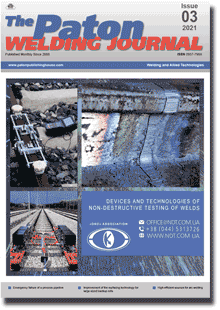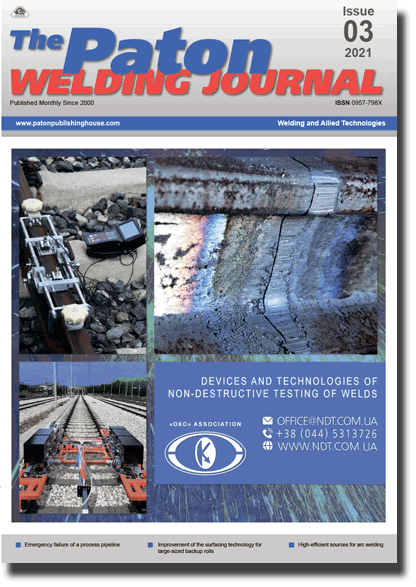| 2021 №03 (04) |
DOI of Article 10.37434/tpwj2021.03.05 |
2021 №03 (06) |

The Paton Welding Journal, 2021, #3, 27-31 pages
Investigation of temperature state of copper plates in the weld zone at friction stir welding
M.A. Polieshchuk, A.V. Shevtsov, I.V. Dotsenko, V.M. Teplyuk, O.V. Kolisnichenko and L.M. Malakhova
E.O. Paton Electric Welding Institute of the NASU. 11 Kazymyr Malevych Str., 03150, Kyiv, Ukraine. E-mail: office@paton.kiev.ua
Abstract
Chromel-alumel thermocouples were used to study the temperature state of 10 mm copper plates at simulation of the process of friction stir welding. Thermocouples were welded on in blind holes located along the line of welding tool movement that allowed recording the copper temperature at the moment of weld formation in different welding modes. In the studied range of variation of process parameters, the metal temperature is mainly influenced by the area of interaction of the welding tool working surface with the plate, while the speed of tool rotation has a minor effect. At the moment of weld formation the metal temperature varied from 528 up to 980 °C in different modes. 13 Ref., 3 Tables, 3 Figures.
Keywords: friction stir welding, copper plates, thermocouples, welds, formation temperature
Received 02.02.2021
References
1. Thomas, W.M. (1991) Friction stir butt welding. Pat. 9125978.8 GB, Publ. 01.12.91.2. Dawes, C., Thomas, W. (1995) TWI Bull., 6, Nov/Dec.
3. Savolainen, K. (2012) DPh: Friction stir welding of copper and microstructure and properties of the weld. Aalto University publication series 13/2012.
4. Manish P. Meshram, Basanth Kumar Kodli, Suhash R. (2014) Dey: Friction stir welding of austenitic stainless steel by pcbn tool and its joint analyses. In: Proc. of 3rd Int. Conf. on Materials Processing and Characterization (ICMPC 2014). https://doi.org/10.1016/j.mspro.2014.07.016
5. Brian T. Thompson. (2010) Thesis: Tool Degradation Characterization in the Friction Stir Welding of Hard Metals. The Ohio State University.
6. De P.S., Kumar N., Mishra R.S. (2005) Fundamentals of Friction Stir Welding. ASM Handbook. 6A, 186-199.
7. Hwang, Y.M., Fan, P.L., Lin, C.H. (2010) Experimental study on friction stir welding of copper metal. J. Materials Proc. Technology, 210, 1667-1672. https://doi.org/10.1016/j.jmatprotec.2010.05.019
8. Pavlova, V.I., Alifirenko, E.A., Osokin, E.P. (2009) Study of temperature-time conditions of welding heating, structure and properties of metal of butt joints from aluminium-magnesium alloy produced by friction stir welding. ISSN 1994-6716. Voprosy Materialovedeniya, 4, 60. St.-Petersburg, TsNII KM Prometey [in Russian].
9. Grigorenko, G.M., Poleshchuk, M.A., Adeeva, L.I. et al. (2016) Peculiarities of structure of Cu-Cu, Ni-Cu and steel- Cu joints produced by overlap friction stir welding method. The Paton Welding J., 5-6, 75-80. https://doi.org/10.15407/tpwj2016.06.13
10. Krasnovsky, K., Khokhlova, Yu.A., Khokhlov, M.A. (2019) Influence of tool shape for friction stir welding on physicomechanical properties of welded joints of EN AW 6082-T6 aluminium alloy. Ibid., 7, 9-15 [in Russian]. https://doi.org/10.15407/as2019.07.02
11. Grigorenko, G.M., Adeeva, L.I., Tunik, A.Yu. et al. (2015) Restoration repair of slab copper moulds of MCCB. Structure and properties of metal in the joint zone. Sovrem. Elektrometal., 1, 44-49 [in Russian]. https://doi.org/10.15407/sem2015.01.07
12. Grigorenko, G.M., Adeeva, L.I., Tunik, A.Yu. et al. (2014) Structural features of FSW joints of metals with different element solubility in the solid phase. The Paton Welding J., 4, 13-23. https://doi.org/10.15407/tpwj2014.04.01
13. https://www.bnl.gov/magnets/Staff/Gupta/cryogenic-datahandbook/ Section 15.pdf.
Suggested Citation
M.A. Polieshchuk, A.V. Shevtsov, I.V. Dotsenko, V.M. Teplyuk, O.V. Kolisnichenko and L.M. Malakhova (2021) Investigation of temperature state of copper plates in the weld zone at friction stir welding. The Paton Welding J., 03, 27-31.The cost of subscription/purchase order journals or individual articles
| Journal/Currency | Annual Set | 1 issue printed |
1 issue |
one article |
| TPWJ/USD | 384 $ | 32 $ | 26 $ | 13 $ |
| TPWJ/EUR | 348 € | 29 € | 24 € | 12 € |
| TPWJ/UAH | 7200 UAH | 600 UAH | 600 UAH | 280 UAH |
| AS/UAH | 1800 UAH | 300 UAH | 300 UAH | 150 UAH |
| AS/USD | 192 $ | 32 $ | 26 $ | 13 $ |
| AS/EUR | 180 € | 30 € | 25 € | 12 € |
| SEM/UAH | 1200 UAH | 300 UAH | 300 UAH | 150 UAH |
| SEM/USD | 128 $ | 32 $ | 26 $ | 13 $ |
| SEM/EUR | 120 € | 30 € | 25 € | 12 € |
| TDNK/UAH | 1200 UAH | 300 UAH | 300 UAH | 150 UAH |
| TDNK/USD | 128 $ | 32 $ | 26 $ | 13 $ |
| TDNK/EUR | 120 € | 30 € | 25 € | 15 € |
AS = «Automatic Welding» - 6 issues per year;
TPWJ = «PATON WELDING JOURNAL» - 12 issues per year;
SEM = «Electrometallurgy Today» - 4 issues per year;
TDNK = «Technical Diagnostics and Non-Destructive Testing» - 4 issues per year.


